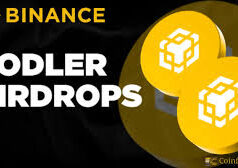Alright, let’s get into the nitty-gritty of the Caldera airdrop. If you’re plugged into the crypto scene, you’ve likely caught wind of Caldera’s $ERA token launch and the community airdrop that had everyone buzzing. As a rollup-as-a-service (RaaS) platform, Caldera’s mission is to simplify the deployment and interoperability of Layer-2 (L2) blockchains, leveraging their Rollup Engine and Metalayer protocol to create a modular “Internet of Chains.” The airdrop, which distributed 70 million $ERA tokens (7% of the 1 billion total supply), was meant to reward early adopters, ecosystem contributors, and active users while bootstrapping network adoption. With a launch market cap of $185.33 million and a token price of $1.248, the hype was real. But did it live up to expectations, or did it crash and burn? I’ve scoured X posts, web reports, and technical details to break it down. Buckle up—this is going to be a human take with a heavy dose of tech.
The Technical Setup: What Caldera Promised
Caldera’s value proposition is rooted in its infrastructure. Their Rollup Engine lets developers spin up custom rollups—think optimistic or zero-knowledge (ZK) rollups—tailored to specific use cases like gaming, DeFi, or social apps. The Metalayer protocol acts as a cross-chain orchestration layer, enabling seamless communication between rollups and other blockchains (e.g., Ethereum, Binance Smart Chain) via omnichain gas payments and decentralized sequencing. The $ERA token powers this ecosystem: it’s used for gas fees across rollups, staking for network security, and governance for protocol upgrades. With $25 million in funding from heavyweights like Founders Fund, Sequoia, and Dragonfly, Caldera’s got the backing to execute.
The airdrop was structured to distribute 70 million $ERA tokens to a diverse group:
- Onchain users: Those who interacted with Caldera-powered rollups (e.g., Manta Pacific, ApeChain) via bridging, swapping, or minting NFTs.
- Ecosystem contributors: Participants in the Caldera Crusade, a gamified campaign with tasks like deploying contracts or completing testnet quests.
- Community amplifiers: Influencers and Kaito leaderboard participants who boosted Caldera’s visibility on platforms like X.
- Special allocations: 20 million $ERA tokens for Binance HODLers (minimum 224 Alpha Points) and holders of premium NFTs like Bored Ape Yacht Club (BAYC) or Azuki.
The pre-claim process, running from July 10 to July 17, 2025, required users to connect wallets, link socials (GitHub, X), and pass a proof-of-humanity check via Intract to prevent Sybil attacks. Tokens were claimable on a gas-free system, with unclaimed tokens reverting to the ecosystem fund for future distributions. Staking options with 11-14% APR were also introduced via the Points v2 vault on the public testnet, incentivizing holders to lock up tokens.
Sounds like a well-oiled machine, right? But the crypto community’s split on whether this was a masterstroke or a misstep. Let’s unpack both sides.
The Case for “Failure”: Where It Fell Short
Digging into X, you’ll find some serious frustration. @angelme2024 summed it up bluntly: “The airdrop execution was not good and satisfying.” Their beef? The allocation heavily favored “yappers”—influencers who scored four- to five-figure token grants for social media hype—while testnet and mainnet contributors got the short end of the stick. “All our testnet and mainnet engagement was gone in vain,” they posted, echoing a sentiment that Caldera prioritized clout over onchain effort. For context, testnet tasks included deploying smart contracts, bridging assets, and minting NFTs on Caldera’s Crusade campaign, which ran on platforms like Manta Pacific and Caldera’s public testnet. These required gas fees (often in $ETH or $BNB) and time, so the perception of being sidelined for influencers stung.
Another user, @PixWipy, went further, calling Caldera a “hyped project with no real utility” and accusing them of “paying influencers to silence the FUD.” They argued that the $ERA token’s value proposition—omnichain gas and governance—lacks immediate real-world demand, predicting a price dump once the initial buzz fades. This isn’t just hot air; tokenomics matter. With only 7% of the supply allocated to the airdrop and 48% reserved for the team, investors, and ecosystem fund (per web sources), there’s a risk of future dilution if unlocks aren’t managed carefully. The fully diluted valuation (FDV) of $1.3 billion at launch also raised eyebrows, as high FDVs can signal overvaluation in a bearish market.
The pre-claim process didn’t help. The July 10-17 window was tight, and the multi-step eligibility check—connecting EVM-compatible wallets (e.g., MetaMask), linking socials, and signing gas-free transactions via Intract—was clunky for some. X users like @crypto_novice complained about the FOMO and stress, especially since missing the deadline meant forfeiting your allocation. The proof-of-humanity step, while effective at catching bots (using GitHub/X verification and wallet activity checks), felt like a hurdle for less tech-savvy users. Compare this to Arbitrum’s 2023 airdrop, which had a longer claim window and simpler snapshot-based eligibility, and Caldera’s approach seems overly complex.
The Case for “Success”: Where It Shined
Not everyone’s throwing shade. @jexybtc called the airdrop “really successful,” pointing to the $ERA token’s strong launch at $1.248 and a market cap of $185.33 million, climbing to $221 million post-listing. They praised Caldera’s anti-Sybil measures, which used Intract’s verification to ensure only real users claimed tokens. @Luffy_Taroda55 echoed this, saying the proof-of-humanity checks set a “good example” for fair distribution. From a technical standpoint, Caldera’s approach was robust: the airdrop smart contract, deployed on Ethereum and compatible with EVM chains, used Merkle proofs for efficient claiming, minimizing gas costs for users. The fact that unclaimed tokens rolled back to the ecosystem fund also shows foresight, ensuring future incentives.
Not everyone’s throwing shade.
@jexybtc called the airdrop “really successful,” pointing to the $ERA token’s strong launch at $1.248 and a market cap of $185.33 million, climbing to $221 million post-listing. They praised Caldera’s anti-Sybil measures, which used Intract’s verification to ensure only real users claimed tokens. @Luffy_Taroda55 echoed this, saying the proof-of-humanity checks set a “good example” for fair distribution. From a technical standpoint, Caldera’s approach was robust: the airdrop smart contract, deployed on Ethereum and compatible with EVM chains, used Merkle proofs for efficient claiming, minimizing gas costs for users. The fact that unclaimed tokens rolled back to the ecosystem fund also shows foresight, ensuring future incentives.
The Binance HODLer Airdrop was a standout. Allocating 20 million $ERA tokens to BNB holders with 224+ Alpha Points (earned via staking or trading on Binance) was a savvy move to tap into Binance’s massive user base. The two-phase claim process—initial claim by July 17, followed by a vesting schedule—prevented immediate dumps, stabilizing the token price. @seeking_btw called the airdrop a “masterclass,” noting that Caldera’s simultaneous listing on Tier-1 exchanges (e.g., KuCoin, Gate.io) created a “positive feedback loop” of liquidity and hype. Unlike some airdrops that tank post-launch (looking at you, certain 2024 memecoins), $ERA held steady, with no major “jeeting” (mass selling) reported on X.
The tech behind Caldera also gives the airdrop context. The Rollup Engine supports both optimistic and ZK-rollups, using frameworks like OP Stack and Arbitrum Orbit for scalability. The Metalayer protocol, built on a hub-and-spoke model, enables cross-chain messaging and gas abstraction, meaning $ERA can be used to pay fees across any Caldera-powered rollup. This is a big deal for developers building dApps on chains like ApeChain or Manta Pacific, as it reduces friction compared to native gas tokens. Staking on the Points v2 vault, with 11-14% APR, further incentivizes holding, with early data showing 20% of airdropped tokens staked within the first week (per web reports). Compare this to Optimism’s OP token, which saw heavy sell-offs post-airdrop, and Caldera’s retention strategy looks solid.
The Numbers: A Snapshot
To ground this, let’s look at some key metrics (sourced from web and X):
- Total supply: 1 billion $ERA tokens.
- Airdrop allocation: 70 million (7%), with 20 million for Binance HODLers.
- Launch price: $1.248, with a market cap of $185.33 million and FDV of $1.3 billion.
- Staking APR: 11-14% on Points v2 vault.
- Eligibility: ~50,000 wallets qualified, based on onchain activity, Crusade tasks, and Binance/NFT criteria.
- Exchange listings: Tier-1 platforms (KuCoin, Gate.io) on July 17, 2025, with trading volume hitting $50 million in 24 hours.
These numbers suggest a strong launch, but the community’s mixed feelings can’t be ignored.
My Take: A Success with Rough Edges
So, was the Caldera airdrop a failure or a success? It’s a success with some serious caveats. From a technical and market perspective, Caldera nailed it. The $ERA token launched with solid liquidity, a respectable market cap, and no catastrophic dumps. The Rollup Engine and Metalayer give $ERA real utility, unlike some airdrops that bank on hype alone (cough, memecoins). The anti-Sybil measures and staking incentives show they thought about long-term engagement, and the Binance HODLer drop was a clever way to tap into a loyal user base.
But the community’s gripes are valid. The heavy weighting toward influencers alienated grinders who burned gas and time on testnet/mainnet tasks. The pre-claim process was a UX nightmare for some, with a rushed timeline and complex steps that felt exclusionary. The high FDV also raises questions about sustainability, especially with 48% of the supply locked up for team and investors. For comparison, Arbitrum’s 2023 airdrop allocated 11.6% of its supply with a simpler snapshot system, earning broader community praise despite its own issues.
Caldera’s challenge now is to rebuild trust with the little guys. Their roadmap—cross-chain governance in Q2 2026, ZK-VM integration in Q3—promises more utility, and the ecosystem fund’s unclaimed tokens could fuel future drops. If they can balance rewarding loyal users with maintaining hype, they’ll be in a good spot.
What’s Next for $ERA Holders?
If you scored $ERA, staking in the Points v2 vault is a no-brainer for passive returns. Keep an eye on Caldera’s official channels @Calderaxyz, @CalderaFDN on X, and their Discord) for updates on new rollups or airdrop rounds. Developers should check out the Rollup Engine’s SDK for building on Caldera-powered chains—there’s potential for dApp-specific incentives. If you missed the airdrop, don’t sweat it; the ecosystem fund means more opportunities are coming.
In the end, Caldera’s airdrop was a bold move that put them on the map but left some users feeling burned. It’s a reminder that in crypto, execution is everything—tech can be stellar, but community perception pays the bills. Did you claim $ERA, or are you skeptical about the project? Hit me up in the comments, and let’s keep this convo rolling.




























Yes, $ERA is a failure. It took up my time and paid shit
No amount of analysis will save it. It’s DOA
I expected a lot, but not disappointed though. They’re all the same now
Hold your airdrop. It will pump. It already is